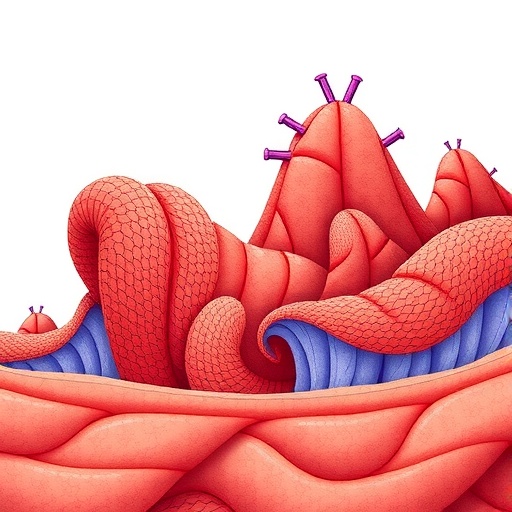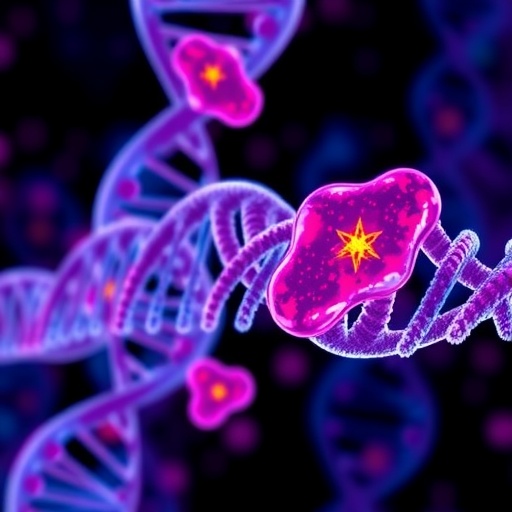In a groundbreaking study recently published in Cell Death Discovery, researchers have uncovered a novel molecular mechanism by which the transcription factor SOX4 alters fatty acid metabolism to suppress ferroptosis in hepatocellular carcinoma (HCC). This discovery not only deepens our understanding of tumor biology but also opens up new avenues for therapeutic intervention in one of the most lethal forms of liver cancer. The research, led by Zhang, Wu, Xiang, and colleagues, elucidates the complex interplay between metabolic reprogramming and cell death pathways, revealing SOX4 as a pivotal regulator that manipulates lipid metabolism through the carbohydrate-responsive element-binding protein (CHREBP) to inhibit ferroptosis.
Ferroptosis, an iron-dependent form of regulated cell death characterized by the accumulation of lipid peroxides, has been increasingly recognized as a crucial process in cancer biology. Unlike apoptosis and necrosis, ferroptosis specifically targets membranes rich in polyunsaturated fatty acids (PUFAs) and is tightly controlled by intracellular antioxidant defenses and metabolic pathways. Its induction is considered a promising therapeutic strategy to eliminate cancer cells that are resistant to conventional treatments. However, cancer cells often develop ingenious mechanisms to evade ferroptosis, contributing to tumor progression and poor prognosis.
The research team has identified SOX4 as a master regulator that reprograms fatty acid metabolism, thereby orchestrating the suppression of ferroptosis in HCC cells. SOX4, a transcription factor known for its role in embryonic development and oncogenesis, is shown to facilitate the expression and activity of CHREBP, a key metabolic sensor that regulates lipogenesis in response to glucose availability. By modulating CHREBP, SOX4 effectively shifts the lipid composition within the cancer cells, promoting the synthesis of monounsaturated fatty acids (MUFAs) at the expense of ferroptosis-susceptible PUFAs.
This metabolic reprogramming has profound implications for the oxidative status of the cell membranes. MUFAs are more resistant to lipid peroxidation compared to PUFAs, and their enrichment within the membrane phospholipids significantly lowers the susceptibility of cancer cells to ferroptotic death. The study’s data demonstrate that SOX4-mediated activation of CHREBP leads to increased expression of enzymes involved in fatty acid desaturation and elongation pathways, reinforcing this protective lipid remodeling. These findings place SOX4 at the nexus of metabolic control and cell fate determination in HCC.
Furthermore, the authors provide compelling evidence that silencing SOX4 or CHREBP re-sensitizes HCC cells to ferroptosis, highlighting the therapeutic potential of targeting this axis. Using both in vitro and in vivo models, they show that disrupting SOX4 signaling enhances the efficacy of ferroptosis inducers, resulting in reduced tumor growth and improved survival outcomes. This suggests that combinatorial therapies incorporating SOX4 inhibitors could overcome resistance mechanisms in liver cancer treatment.
The study also delves into the molecular underpinnings of SOX4-driven regulation, identifying specific binding motifs on the CHREBP promoter that facilitate transcriptional activation. Chromatin immunoprecipitation assays coupled with reporter gene analyses confirm the direct engagement of SOX4 with the CHREBP gene locus. This precise mechanistic insight provides a framework for the development of targeted drugs that can disrupt this interaction, offering a highly specific approach to modulate fatty acid metabolism in cancer cells.
Importantly, the research sheds light on the broader metabolic landscape of HCC. The reprogramming of fatty acid metabolism by SOX4 not only impacts ferroptosis but may also influence other oncogenic processes such as membrane fluidity, energy production, and signaling cascades related to tumor survival and metastasis. This multifaceted role underscores the complexity of metabolic adaptation in cancer and the need for integrated therapeutic strategies that address these interconnected pathways.
Moreover, by uncovering the role of SOX4 in fatty acid desaturation and the suppression of ferroptosis, the study invites reconsideration of current therapeutic regimens. Drugs that modulate lipid metabolism, previously considered only for metabolic disorders, may find renewed purpose in oncology when paired with ferroptosis-inducing agents. This cross-disciplinary approach exemplifies the future of precision medicine, where insights from basic biology translate into actionable treatments.
The findings also provoke further questions about the potential involvement of SOX4 and CHREBP in other cancer types exhibiting metabolic resilience. Given the ubiquitous nature of fatty acid metabolism and the conserved function of these factors, it is plausible that similar mechanisms operate in diverse malignancies. Systematic exploration across tumor models could reveal universal or context-dependent modes of ferroptosis resistance, broadening the impact of this discovery.
In addition, the extensive lipidomic analyses provided in the paper underscore the critical importance of membrane composition in regulating cell death pathways. The enrichment of MUFAs at the expense of PUFAs shifts the balance of oxidative stress responses, emphasizing the dynamic interplay between metabolism and redox biology in cancer. These insights highlight the need for comprehensive profiling of tumor lipidomes to identify vulnerabilities and predict therapeutic outcomes.
Another intriguing aspect of the study is the potential link between glucose metabolism and ferroptosis regulation through CHREBP. As a carbohydrate-responsive element-binding protein, CHREBP integrates nutrient availability cues with lipid biosynthesis, aligning metabolic states with cell survival strategies. This connection suggests that metabolic interventions targeting glucose flux or glycolytic pathways could indirectly influence ferroptosis sensitivity by modulating CHREBP activity and subsequent lipid remodeling.
The translational relevance of these findings cannot be overstated. Hepatocellular carcinoma remains a formidable clinical challenge due to its late diagnosis, aggressive progression, and resistance to existing therapies. By unveiling the SOX4-CHREBP axis as a novel mediator of ferroptosis evasion, this study offers a promising target that could be exploited to improve therapeutic responses and patient outcomes.
As the research community continues to decode the intricate networks governing tumor metabolism and cell death, this study stands out for its elegant integration of transcriptional regulation, lipid biochemistry, and ferroptotic pathways. The work of Zhang and colleagues represents a significant advance in our understanding of how cancer cells manipulate metabolic circuits to gain survival advantages and evade ferroptosis.
Future investigations will undoubtedly explore the clinical utility of SOX4 and CHREBP inhibitors, alone or in combination with established ferroptosis inducers, across various stages and subtypes of HCC. Moreover, identifying biomarkers that reflect the activity of this axis could help stratify patients most likely to benefit from such targeted therapies.
In conclusion, the discovery that SOX4 reprograms fatty acid metabolism through CHREBP to inhibit ferroptosis reveals a sophisticated survival strategy exploited by hepatocellular carcinoma. This insight not only enriches the current knowledge of tumor biology but also unlocks new therapeutic opportunities aimed at overcoming drug resistance and enhancing the efficacy of ferroptosis-based cancer treatments. With continued research and clinical translation, targeting the SOX4-CHREBP metabolic axis holds promise for transforming the landscape of liver cancer therapy.
Subject of Research: Regulation of fatty acid metabolism and ferroptosis in hepatocellular carcinoma by SOX4 and CHREBP.
Article Title: SOX4 reprograms fatty acid metabolism through the CHREBP to inhibit ferroptosis in hepatocellular carcinoma.
Article References:
Zhang, F., Wu, Z., Xiang, Y. et al. SOX4 reprograms fatty acid metabolism through the CHREBP to inhibit ferroptosis in hepatocellular carcinoma. Cell Death Discov. 11, 246 (2025). https://doi.org/10.1038/s41420-025-02527-4
Image Credits: AI Generated
DOI: https://doi.org/10.1038/s41420-025-02527-4
Tags: cancer cell death pathwayscarbohydrate-responsive element-binding proteinfatty acid metabolism reprogrammingferroptosis in cancerhepatocellular carcinoma researchiron-dependent cell death mechanismslipid metabolism regulationlipid peroxides accumulation in tumorsresistance to ferroptosis in cancerSOX4 transcription factortherapeutic intervention in liver cancertumor biology advancements





